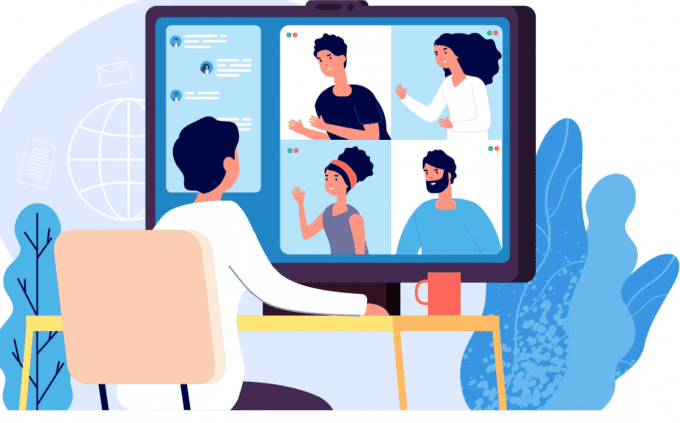The benefits of a classic classroom session led by a passionate instructor cannot be overstated. The engagement and retention levels of a great instructor-led session can virtually never be matched by self-paced learning.
However, there are several barriers that prevent organizations from investing in instructor-led sessions. While there is the obvious challenge of social distancing right now, even before the world was taken over by a pandemic, instructor-led sessions were an expensive undertaking.
Besides paying the instructor, organizations had to bear the cost of their traveling and lounging. Moreover, organizations would also have to invest in the infrastructure needed for a classroom-style session.

Hence, virtual instructor-led sessions rose as a superb alternative to the traditional instructor-led sessions. Virtual classrooms closely resemble the experience of a traditional classroom, and conducting virtual training sessions does not incur the additional costs of infrastructure, travel, and accommodation.
With that said, virtual instructor-led sessions have their own challenges. The use of technology and a physical distance creates a gap between the learner and the instructor. For instance, an instructor cannot see the learners’ faces to gauge whether or not they are able to understand the concept that is being explained to them.
While this gap is a real challenge, it surely doesn’t mean that you can’t deliver effective training over a virtual stream.
It just means that you will have to take care of a few extra things to ensure your online training sessions are as smooth as your in-classroom sessions.
Whether you are an instructor or a learning administrator, these tips will surely help you improve the effectiveness of your virtual instructor-led sessions:
1. Choose The Right Web Conferencing Software

Click here to choose the right web conferencing solution is perhaps the most crucial decision when it comes to providing online training sessions. When choosing a video conferencing tool, there are two major things that you need to think about:
Features: Make sure the video conferencing tool you choose offers features that are geared towards conducting online training. We’re talking about features like a virtual whiteboard, screen sharing, instant chat feature, integrated video recording tools, and any other features that you may find necessary to deliver your training session.
User-Friendliness: The user-friendliness of your video conferencing software has dual importance. One, you need a user-friendly software to be able to efficiently conduct the training session. Two, you need to ensure the user interface is simple enough for your learning audience.
2. Do A Practice Session

Once you have made a decision about the choice of video conferencing tool, it is time to test it out. For this, ask one of your friends/family members to be your student in a different room and try conducting a training session with them.
This way, you can not only test the abilities of your conferencing software but can also make sure you are able to communicate the concept clearly to your learners. You can ask for feedback on the test lesson from your friend/family member and optimize your delivery accordingly.
3. Regularly Ask Learners For Feedback

Speaking of feedback, the best way to ensure that your learners are able to understand you during a virtual instructor-led session is to ask for feedback at regular intervals.
In other words, simply make it a point to ask your learners whether they understood everything in the lecture from time to time. These pauses will give them the chance to ask questions and clear up their doubts.
Don’t just limit the feedback to the live sessions. Make sure you also send out regular surveys to your students to identify if there are any aspects of the virtual training session that are acting as a deterrent. The more you invest in understanding these challenges faced by your learners, the better you can design your online instructor-led session for them.
4. Provide Early Access To Resources

Whatever the topic/subject may be, there are always supplemental study resources that a learner can use to improve their understanding. Sharing such resources, along with the resources that are part of your online lecture, will give your learners a chance to come prepared for the session. These resources can be anything ranging from PowerPoint presentations to instructional videos.
Once a student/learner has had the chance to go over the topics and information that will be shared in an upcoming session, you have a chance to make the session even more productive by focussing on the concepts/parts that the student has identified as difficult.
5. Keep It Short And Crisp

The average internet user has a very short attention span. Hence, it is important to ensure your online sessions address this issue.
By replacing long drawn sessions with short and regularly held sessions, you can ensure a better level of engagement and, in turn, comprehension and retention of information for your learners.
The practice of breaking down long-form training content into bite-sized pieces of information is known as Microlearning and is a known strategy to improve the effectiveness of training. According to the Journal of Applied Psychology, microlearning strategies can result in 17% more efficient transfer of information.
That is probably why learners and instructors both prefer microlearning as a strategy for delivering effective and impactful training.
6. Think Of What Happens After The Session

After you have delivered your online session, it is advisable to follow it up with some study material or an exercise that reinforces the information discussed during the session. This way, a learner can solidify their understanding of the concepts while also realizing if they need any additional help regarding the topics or concepts discussed during the lecture.
Moreover, such an exercise would also allow you to effectively track the progress your learners are making.
Conclusion
In order to make virtual training sessions successful, special efforts are needed from instructors. What steps have you taken to improve the effectiveness of your online training sessions?









